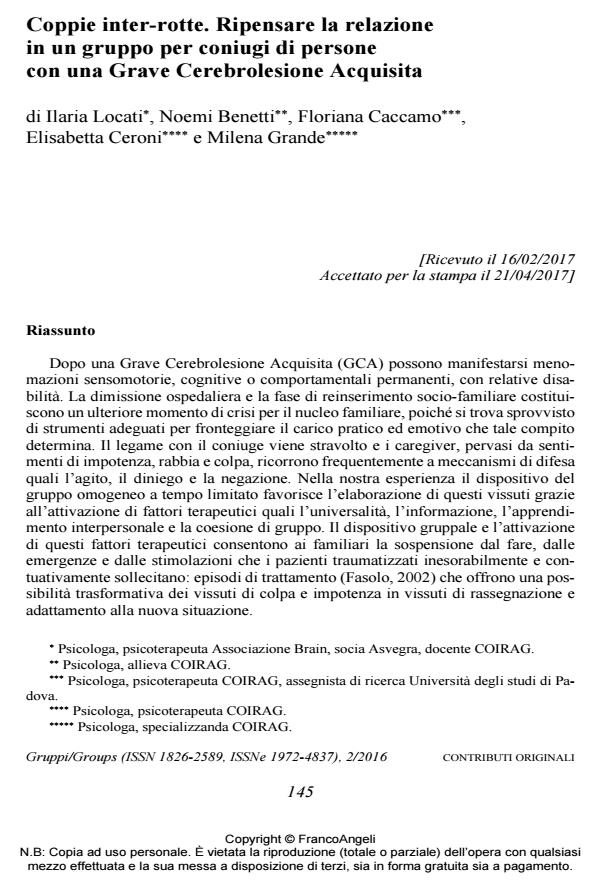Broken couple. How to think a new relationship in a group with partners of traumatic brain injured patients
Journal title GRUPPI
Author/s Ilaria Locati, Noemi Benetti, Floriana Caccamo, Elisabetta Ceroni, Milena Grande
Publishing Year 2017 Issue 2016/2
Language Italian Pages 15 P. 145-159 File size 199 KB
DOI 10.3280/GRU2016-002012
DOI is like a bar code for intellectual property: to have more infomation
click here
Below, you can see the article first page
If you want to buy this article in PDF format, you can do it, following the instructions to buy download credits

FrancoAngeli is member of Publishers International Linking Association, Inc (PILA), a not-for-profit association which run the CrossRef service enabling links to and from online scholarly content.
After an Acquired Brain Injury (ABI) there might be problems in the areas of thinking and behaviour which are not as easy to see and recognise as many physical disabilities. The patient and his family run into a traumatic event (the ABI) which is sudden, uncontrollable and intensive. After discharge the phase of family and community reintegration can have a new traumatic impact on the family members. The couple relationship is actually broken and partners have to manage personality changes and the loss of affection, together with all the other daily stresses and strains, which can sometimes be very difficult to overcome. They can feel helplessness, anger and guilt and turn to defence mechanism such as acting out, denial and negation. In our experience the homogeneous, time-limited groups for family members help working through these feelings, increasing the effect of therapeutic factors such as universality, imparting information, interpersonal learning, and group cohesiveness. Group treatments (Fasolo, 2002) increase the chance to modify guilty and helplessness feelings into resignation and adaptation feelings.
Keywords: Trauma, Group, Homogeneous groups, Time-limited groups, Couple relationship, Therapeutic factors.
- Bloch S. & Crouch E. (1985). Therapeutic Factors in Group Psychotherapy. Oxford: Oxford University Press.
- Compostella S. (2004). Il gruppo omogeneo per familiari di pazienti con trauma cranico. In: Corbella S., Girelli R. e Marinelli S., a cura di, Gruppi omogenei. Roma: Borla.
- Fasolo F. (2002). Gruppi che curano e gruppi che guariscono. Padova: La Garangola.
- Fischetti R. (2014). Psicoanalisi della famiglia: le sofferenze della famiglia oggi. In: Bianchera L. e Cavicchioli G., a cura di, Il lavoro psicosociale con le famiglie vulnerabili. Clinica, teorie e racconti. Padova: Unipress.
- Laplanche J. e Pontalis J.B. (1967). Enciclopedia della psicoanalisi. Bari: Laterza, 1968.
- Locati I., Caccamo F. e Marogna C. (2013). Pazienti in cerca di gruppi: gruppi omogenei con coniugi e figli di pazienti con Grave Cerebrolesione Acquisita. In: Vasta F., Girelli R. e Gullo S., a cura di, Quale omogeneità nei gruppi? Roma: Alpes.
- Lo Verso G. e Ferraris L. (2011). Il familiare nella terapia gruppoanalitica. In: Lo Verso G. e Di Blasi M., a cura di, Gruppoanalisi soggettuale. Milano: Raffaello Cortina.
- Pichon Rivière E. (1956). La teoria del vinculo. Buenos Aires: Nueva Vision.
- Salizzato S., Cimenti F. e Bargellesi S. (2010). Gruppi di sostegno psicologico per familiari di persone con Grave Cerebrolesione Acquisita: spunti di riflessione. MR Giornale Italiano di Medicina Riabilitativa, 24, 3: 51-54.
- Vasta F.N. (2004). Interviste a Howard D. Kibel, Robert D. Hinshelwood, Robi Friedman. In: Corbella S., Girelli R. e Marinelli S., a cura di, Gruppi omogenei. Roma: Borla.
Ilaria Locati, Noemi Benetti, Floriana Caccamo, Elisabetta Ceroni, Milena Grande, Coppie inter-rotte. Ripensare la relazione in un gruppo per coniugi di persone con una Grave Cerebrolesione Acquisita in "GRUPPI" 2/2016, pp 145-159, DOI: 10.3280/GRU2016-002012